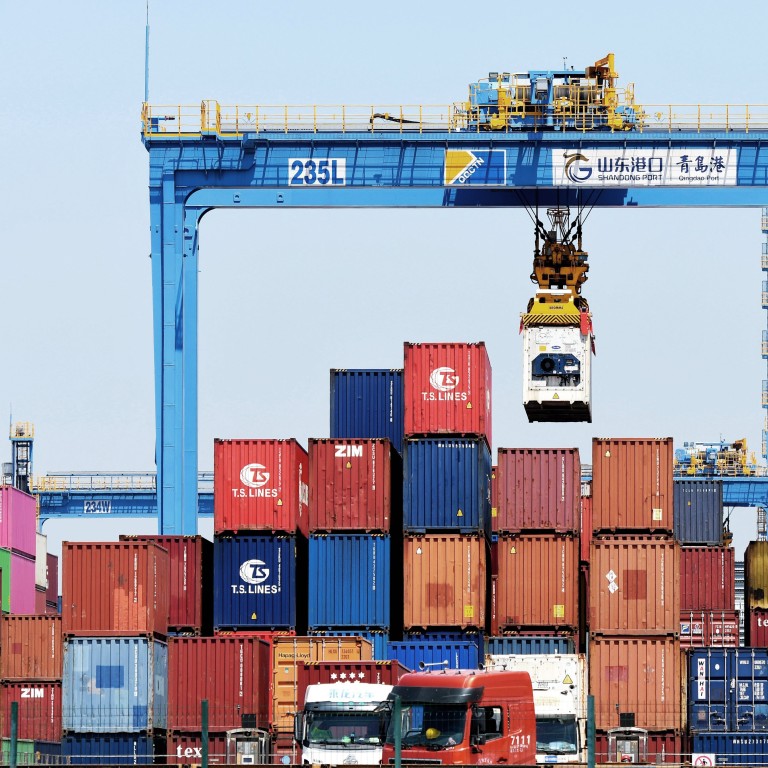
China trade ‘likely to slow down’ in second half of year despite strong imports, exports in June
- China’s exports grew by 32.2 per cent in June compared with a year earlier, up from 27.9 per cent growth in May
- China’s imports grew by 36.7 per cent last month, year on year, down from 51.1 per cent growth in the previous month
China’s trade may slow in the second half of year, according to the customs administration, despite strong imports and exports in June, which both beat expectations.
This was the 12th consecutive period of export growth, although the fact that exports rose by just 0.5 per cent in June last year due to the impact of the coronavirus means the latest figures started from a low base.
The year-on-year growth rate of imports and exports in the second half of the year is likely to slow down, while the trade throughout the year is still expected to maintain a rapid growth
Imports grew by 36.7 per cent in June from a year earlier, to US$229.89 billion – down from the 51.1 per cent growth in May, according to data from China’s General Administration of Customs. This was also above the result of the Bloomberg survey, which predicted 29.3 per cent growth.
“Due to a higher base one year ago, the year-on-year growth rate of imports and exports in the second half of the year is likely to slow down, while the trade throughout the year is still expected to maintain a rapid growth,” Chinese customs spokesman Li Kuiwen said on Tuesday.
China’s total trade surplus stood at US$51.53 billion in June, compared with US$45.53 billion in May.
Headline trade growth was stronger than expected last month, partly thanks to easing shortages of semiconductors. But exports remained below their recent peak and we still think shipments will soften in the coming quarters
“Headline trade growth was stronger than expected last month, partly thanks to easing shortages of semiconductors. But exports remained below their recent peak and we still think shipments will soften in the coming quarters,” said Julian Evans-Pritchard, senior China economist at Capital Economics.
“The latest data suggests that easing supply shortages and still strong demand have helped to shore up trade volumes recently. That said, we continue to think that, with trade volumes still well above their pre-virus trend, they will drop back over the coming quarters.
“The pandemic-induced surge in retail sales in advanced economies has started to reverse recently as consumption patterns begin to normalise amid reopening. Once retailers in these countries have rebuilt their inventories, softer consumer demand will feed through into weaker foreign demand for Chinese exports.
“Meanwhile, the recent pullback in credit growth is likely to weigh on import volumes as the composition of domestic expenditure shifts from investment toward consumption.”
In the first half of 2021, China’s exports rose by 38.6 per cent year on year to US$1.52 trillion, while imports rose 36.0 per cent over the same period to US$1.27 trillion.
China’s trade surplus, meanwhile, was US$251.52 billion in the first half of the year.
Also in the first half of 2021, China imported 561 million tonnes of iron ore, up 2.6 per cent from a year earlier.
Corn imports soared by 318.5 per cent to 15.302 million tonnes in the first six months of the year, while imports of wheat jumped by 60.1 per cent to 5.368 million tonnes. Imports of soybeans also rose by 8.7 per cent to 48.955 million tonnes.
In the same period, imports of crude oil fell by 3 per cent to 261 million tonnes, while imports of natural gas rose by 23.8 per cent to 59.819 million tonnes.
In June, China’s trade surplus with the United States rose to US$32.58 billion from US$31.78 billion in May. June’s figure was up by 10.78 per cent from a year earlier.
China’s imports from the US rose by 37.55 per cent to US$14.33 billion in June, while exports rose by 17.78 per cent to US$46.91 billion.
In terms of other trading partners, China’s exports to European Union rose by 27.2 per cent to US$43.10 billion in June compared with a year earlier, while imports rose by 34.1 per cent to US$27.74 billion. China’s trade surplus with the European Union in June was US$15.36 billion, up 16.37 per cent from a year earlier.
China’s exports to Australia rose to US$5.48 billion in June, a year-on-year increase of 27.69 per cent, while imports rose by 53.51 per cent compared with last year, to US$14.67 billion. This led to China’s trade deficit with Australia rising by 74.54 per cent from a year earlier to US$9.19 billion.
The Association of Southeast Asian Nations (Asean) remained China’s largest trading partner, followed by the European Union and the United States.
China’s exports to the Asean bloc rose by 33.14 per cent to US$40.36 billion in June compared with a year earlier, while imports rose by 33.69 per cent to US$33.74 billion. China’s trade surplus with the Asean states was US$6.63 billion in June, up 30.42 per cent from a year earlier.

.JPG?itok=J8tgfPmW&v=1659948715)
